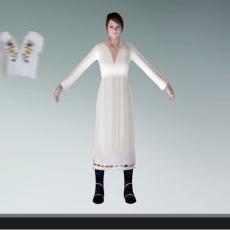Overview
 The attire of women in Roumlouki, characterized by austerity and rigor of the material, without of course lacks the elegance, since locals tailors looked to embellish with rich variety of designs and embroidery and women themselves to weave with more ornaments.
Female outfit of Roumlouki is basically the same in pieces, differing mainly in the headband or the colors and decor in some of these to single women , the honeymooners, the elderly or widows.
The attire of women in Roumlouki, characterized by austerity and rigor of the material, without of course lacks the elegance, since locals tailors looked to embellish with rich variety of designs and embroidery and women themselves to weave with more ornaments.
Female outfit of Roumlouki is basically the same in pieces, differing mainly in the headband or the colors and decor in some of these to single women , the honeymooners, the elderly or widows.
The young women, until they enter into marriage wore dresses, particularly long dresses up to under the knee of different colors, which were adorned with lace and embroidery on the collar, the sleeves and on the hem.
When they married, they wore the whole suit, that is Katastari, shirt, jabot, the sayias, velvet aprons, the belt, the “kontosi” with gold embroidery on the colla, on the front edges and on the hem, the broumanika (epimanikia) with 12 small bells (koukourekia), the apron,woolen socks (skoufounia), the “gourounotsaroucha” on weekdays and the “boutinia” on celebrations and of course all of their jewelery consisting of a string with coins, the chain with eight ntoubles (fiver), the silver cross, the “maglikoutari” (the main jewel in headband), the “tokades”, the “mamoudiedes”, the “pafilia”, the silver knife, the chains, the “doulia”, the bilitzikia (bracelets) and the “tsourakia” (earrings). At their head tied the headband, the ” katsouli” and the newlyweds up from it two or three tassels.
The Katsouli
Special mention deserves the “katsouli”, that is the women headband, which gives great pomp and grandeur throughout the suit, making it known throughout Greece for the similarity of “katsouli” with the ancient Homeric and Macedonian helmet and tradition that connects with Alexander the Great.
The women of Roumlouki wore it for the first time on their wedding day and departed not only a very old age and many of them at all until they die.The katsouli consists of the main katsouli, which is oval shaped, protruding headband and gives its name to the whole of this, and three handkerchiefs, two white and one black, the “darma” which has embroidery on one corner, the “tsemperi” and the “mafesi”.
The tradition at Roumlouki wants the “katsouli” as a gift of Alexander the Great to the women of the region, for the bravery they showed fighting against some barbarian tribe, who raided the time in the plain of Roumlouki repelled it with success. In more than 50 villages of Roumlouki preserved the same tradition with several variations.
Women from ROUMLOUKI were quite proud of the katsouli and was not taken off ever, not even in harsh working conditions during the summer in the fields. They didn’t abandoned it even when the Bulgarians guerillas blackmailed to do so during the Macedonian Struggle early this century, considered as the point of Hellenism, nor when the Greek Consulate in Thessaloniki, issued an order to be replaced it with European scarves, in other for hygienic reasons of the head and by others as it is a Bulgarian origin.
Definitively, women from Roumlouki start making the “katsoula” after the Second World War. Then started to fade in the region, the old universal homogeneity of the population by installing refugee in Roumlouki from Asia Minor, Eastern and Northern Thrace and the Pontos and coexistence with them, (in conjunction with the products of industrial production which began to inundate the villages), brought new customs and altered the lives of people of Roumlouki.